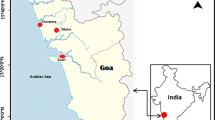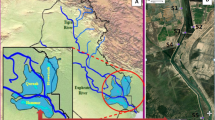Abstract
Data are presented for 13 trace metals (Cr, Mn, Fe, Co, Ni, Cu, Zn, As, Se, Mo, Ag, Cd, and Pb) in 38 bivalve mussels Anodonta woodiana from four separate sites (Huzhou, Dapu, Sansandao, and Manshan) around the Taihu Lake of China. All elemental concentrations generally ranked in decreasing order, Mn > Fe > Zn > As ≈ Cu ≈ Cd ≈ Se > Pb > Mo ≈ Ag, except that Cr, Co, and Ni were not detected. Anodonta woodiana was able to bioaccumulate essential Mn and toxic Cd to the extremely high level of 19,240 and 53 mg/kg dry weight, respectively. Geographical differences in the concentrations of trace elements were usually significant between sampling sites except for As and Pb, and the mussels from Sanshandao site had mostly accumulated or were contaminated with essential and toxic elements. The residue level of Cd in A. woodiana from the Sanshandao and Manshan sites appeared to be even higher than those of the essential elements Cu and Se, and exceeded the corresponding maximum residue limits of China. The present study provides the most recent information on trace element bioaccumulation or contamination in Taihu Lake and, further, suggests that A. woodiana can be used as a suitable bioindicator for inland water environmental monitoring.


Similar content being viewed by others
References
Baden SP, Neil DM (1998) Accumulation of manganese in the haemolymph. nerve and muscle tissue of Nephrops norvegicus (L.) and its effect on on neuromusculator performance. Comp Biochem Physiol A 119:351–359
Bian X, Liu H, Gan J, Yang J (2008) Residues of PCBs in Anodonta woodiana from the Taihu Lake, China. J Agro-Environ Sci 27:767–772 (in Chinese with English abstract)
Bian X, Liu H, Gan J, Li R, Yang J (2009) HCH and DDT residues in bivalves Anodonta woodiana from Taihu Lake, China. Arch Environ Contam Toxicol 56:67–76
Bootsma N, Macey DJ, Webb J, Talbot V (1988) Isolation and characterisation of ferritin from the hepatopancreas of the mussel Mytilus edulis. BioMetals 1:106–111
Dafre AL, Medeiros ID, Muller IC, Ventura EC, Bainy AC (2004) Antioxidant enzymes and thiol/disulfide status in the digestive gland of the brown mussel Perna perna exposed to lead and paraquat. Chem Biol Interact 149:97–105
Dagnac T, Padró A, Rubio R, Rauret G (1999) Speciation of arsenic in mussels by the coupled system liquid chromatography–UV irradiation–hydride generation inductively coupled plasma mass spectrometry. Talanta 48:763–772
Dobrowolski R, Skowrońska M (2001) Distribution and environmental mobility of selected trace metals in the Zemborzyce Reservoir. Pol J Environ Stud 10:383–388
Dong Z (2002) The molecular mechanisms of arsenic-induced cell transformation and apoptosis. Environ Health Persp 110(Suppl 5):757–759
Eisler R (1989) Molybdenum hazards to fish, wildlife, and invertebrates: a synoptic review. In: Contaminant Hazard Reviews, Report No. 19. U.S. Department of the Interior, Fish and Wildlife Service, Washington, DC
Eisler R (1993) Zinc hazards to fish wildlife and invertebrates: a synoptic review. In: Contaminant Hazard Reviews, Report No. 26. U.S. Department of the Interior, Fish and Wildlife Service, Washington, DC
Goldberg ED (1975) The Mussel Watch—a first step in global marine monitoring. Mar Pollut Bull 6:111
Goldberg ED, Koide M, Hodge V, Flegal AR, Martin J (1983) U.S. Mussel Watch: 1977–1978 results on trace metals and radionuclides. Estuar Coast Shelf Sci 16:69–93
Goyer RA, Clarkson TW (2001) Toxic effects of metals. In: Klassen CD (ed) Casarett and Doull’s toxicology: the basic science of poisons, 6th edn. McGraw–Hill, New York, pp 811–868
Gundacker C (2000) Comparison of heavy metal bioaccumulation in freshwater molluscs of urban river habitats in Vienna. Environ Pollut 110:61–71
Guo L (2007) Doing battle with the green monster of Taihu Lake. Science 317:1166
Hernroth B, Baden SP, Holm K, Andre T, Soderhall I (2004) Manganese induced immune suppression of the lobster, Nephrops norvegicus. Aqua Toxicol 70:223–231
Jia XP, Lin Q, Zhou GJ, Cai WG, Li CH, Gan JL (2003) The establishment and utilization of the ‘‘South China Sea Mussel Watch Program’’ system. In: Jia XP (ed) Study on the sustainable development of marine fishery in South China Sea. Science Press, Beijing, pp 32–41 (in Chinese)
Klassen CD (2001) Casarett and Doull’s toxicology: the basic science of poisons, 6th edn. McGraw-Hill, New York
Królak E, Zdanowski B (2001) The bioaccumulation of heavy metals by the mussels Anodonta woodiana (Lea, 1834) and Dreissena polymorpha (Pall.) in the heated Konin lakes. Arch Pol Fish 9:229–237
Lehtonen KK, Leiniö S, Schneider R, Leivuori M (2006) Biomarkers of pollution effects in the bivalves Mytilus edulis and Macoma balthica collected from the southern coast of Finland (Baltic Sea). Mar Ecol Prog Ser 322:155–168
Liu H, Yang J, Gan J (2009) Residues of mercury in the bivalve mussels Anodonta woodiana from the Wulihu area of the Taihu Lake, China. J Agro-Environ Sci 28:64–69 (in Chinese with English abstract)
Martin K, Huggins T, King C, Carroll MA, Catapane EJ (2008) The neurotoxic effects of manganese on the dopaminergic innervation of the gill of the bivalve mollusc, Crassostrea virginica. Comp Biochem Physiol C 148:152–159
Mertz W (1981) The essential trace elements. Science 213:1332–1338
Nakata H, Hirakawa Y, Kawazoe M, Nakabo T, Arizono K, Abe S, Kitano T, Shimada H, Watanabe I, Li W, Ding X (2005) Concentrations and compositions of organochlorine contaminants in sediments, soils, crustaceans, fishes and birds collected from Lake Tai, Hangzhou Bay and Shanghai city region, China. Environ Pollut 133:415–429
Ng TYT, Wang WX (2005) Subcellular controls of silver biokinetics in the green mussel Perna viridis from two hydrographic zones. Mar Ecol Prog Ser 299:193–204
Oremland RS, Stolz JF (2003) The ecology of arsenic. Science 300:939–944
Oweson C, Sköld H, Pinsino A, Matranga V, Hernroth B (2008) Manganese effects on haematopoietic cells and circulating coelomocytes of Asterias rubens (Linnaeus). Aqua Toxicol 89:75–81
Pourang N, Richardson CA, Mortazavi MS (2009) Heavy metal concentrations in the soft tissues of swan mussel (Anodonta cygnea) and surficial sediments from Anzali wetland, Iran. Environ Monit Assess 163:195–213
Ravera O, Cenci R, Beone GM, Dantas M, Lodigiani P (2003) Trace element concentrations in fresh water mussels and macrophytes as related to those in their environment. J Limnol 62:61–70
Rossman TG (2003) Mechanism of arsenic carcinogenesis: an integrated approach. Mutat Res 533:37–65
Scott DM, Major CW (1972) The effect of copper(II) on survival, respiration, and heart rate in the common blue mussel, Mytilus edulis. Biol Bull 143:679–688
Shen L, Lin GF, Tan JW, Shen JH (2000) Genotoxicity of surface water samples from Meiliang Bay, Taihu Lake, Eastern China. Chemosphere 41:129–132
Shen PP, Shi Q, Hua ZC, Kong FX, Wang ZG, Zhuang SX, Chen DC (2003) Analysis of microcystins in cyanobacteria blooms and surface water samples from Meiliang Bay, Taihu Lake, China. Environ Int 29:641–647
Soroka M (2005) Genetic variability among freshwater mussel Anodonta woodiana (Lea, 1834) (Bivalvia: Unionidae) populations recently introduced in Poland. Zool Sci 22:1137–1144
Szefer P, Ali AA, Ba-Haroon AA, Rajeh AA, Ge don J, Nabrzyski M (1999) Distribution and relationships of selected trace metals in molluscs and associated sediments from the Gulf of Aden, Yemen. Environ Pollut 106:299–314
Tran D, Moody AJ, Fisher AS, Foulkes ME, Awadhesh NJ (2007) Protective effects of selenium on mercury-induced DNA damage in mussel haemocytes. Aqua Toxicol 84:11–18
Usero J, GonzBlez-Regalado E, Gracia I (1997) Trace metals in the bivalve molluscs Ruditapes decussatus and Ruditapes philippinarum from the Atlantic coast of southern Spain. Environ Int 23:291–298
Usero J, Morillo J, Gracia I (2005) Heavy metal concentrations in molluscs from the Atlantic coast of southern Spain. Chemosphere 59:1175–1181
Van Holde KE, Miller KI, Decker H (2001) Hemocyanins and invertebrate evolution. J Biol Chem 276:15563–15566
Webb J, Macey DJ, Talbot V (1985) Identification of ferritin as a major high molecular weight zinc-binding protein in the tropical rock oyster, Saccostrea cuccullata. Arch Environ Contam Toxicol 14:403–407
Wenchuan Q, Dickman M, Sumin W (2001) Multivariate analysis of heavy metal and nutrient concentrations in sediments of Taihu Lake, China. Hydrobiologia 450:83–89
Xiang Y, Miao QL, Feng JF (2006) Pollution of heavy metals in the bottom mud of Lake Taihu and its assessment of potential ecological risk. J Nanjing Inst Meteor 29:700–705 (in Chinese with English abstract)
Yang J, Miyazaki N, Kunito T, Tanabe S (2006) Trace elements and butyltins in a Dall’s porpoise (Phocoenoides dalli) from Sanriku coast of Japan. Chemosphere 63:449–457
Yang J, Harino H, Liu H, Miyazaki N (2008) Monitoring the organotin contamination in the Taihu Lake of China by bivalve mussel Anodonta woodiana. Bull Environ Contam Toxicol 81:164–168
Yang W, Yang L, Zheng J (1996) Effect of metal pollution on the water quality in Taihu Lake. GeoJournal 40:197–200
Zhang Y, Meng Q, Jiang T, Wang H, Xie L, Zhang R (2003) A novel ferritin subunit involved in shell formation from the pearl oyster (Pinctada fucata). Comp Biochem Physiol B 135:43–54
Acknowledgments
This work was supported by Natural Science Funds of Jiangsu Province (Grant No. BK2006030), the Ministry of Personnel (Grant No. 2-115084), and the Key Laboratory of Fishery Ecological Environment, Ministry of Agriculture of China (Grant No. 2007-1).
Author information
Authors and Affiliations
Corresponding author
Rights and permissions
About this article
Cite this article
Liu, H., Yang, J. & Gan, J. Trace Element Accumulation in Bivalve Mussels Anodonta woodiana from Taihu Lake, China. Arch Environ Contam Toxicol 59, 593–601 (2010). https://doi.org/10.1007/s00244-010-9521-6
Received:
Accepted:
Published:
Issue Date:
DOI: https://doi.org/10.1007/s00244-010-9521-6




